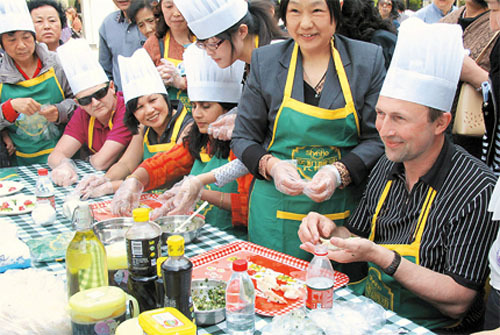For the many expats living in "multinational" Changning District, the experience gives them a taste of home. Around 54,000 foreign residents from 114 countries and regions make their home in Changning.
|

Expat residents in Changning District learn to make jiaozi (Chinese dumpling stuffed with sliced pork and vegetables) at a community event. (Shanghai Daily photo)
|
One of the city's most international districts, Changning is also home to 23 consulates and more than 3,600 foreign enterprises and institutions.
While cultural strains may occur due to differences in culture, customs and religions, the local government provides services aimed to eliminate misunderstandings, improve communication, and help foreigners adapt and integrate smoothly.
The district is attracting more foreign residents because of its convenient transport, good schools (seven international), high-quality medical service, good sanitation, cultural offerings and resident-oriented community services.
The district motto is "convenient, comfortable and cheerful."
The government provides foreign residences a "Living in Changning Guidebook and Map" in English, a bilingual monthly newsletter and a multi-language official Website in English, Japanese, South Korean and French. Useful topical brochures in English are available.
The guidebook is virtually an encyclopedia about the district. It covers basics such as climate, customs and foreign policies as well as practical information about education, real estate, shopping, dining, tourism and postal service.
"Changning Basic Facts" is a bilingual (English and Chinese) description of the district's economy, communities and culture.
"Overseas Residents in Changning" brochure tells the stories of 19 foreign residents.
Changning has several international schools, including Yew Chung International School of Shanghai and Shanghai Changning International School, plus over 10 bilingual schools. They represent one-third of the total foreign schools in Shanghai.
Since 2002, 10 foreign teachers have been added to 10 district middle and elementary schools and they cultivate an English-learning atmosphere among local students.
Medical services in Changning also meet international standards.
Shanghai United Family Hospital and Clinics and Shanghai Green Clinic are both joint ventures targeting Westerns and Japanese.
Another 14 hospitals such as Shanghai Chen Xin Hospital and SunTec Medical Center provide medical services mainly to South Korean and Taiwanese.
An open mind enables both local and foreign residents to appreciate cultural diversity.
The Shanghai Hongqiao International Library, established in 2007, offers more than 9,000 books and magazines in 11 languages, including English, French, Russian and Japanese. It covers 16,000 square meters and can accommodate 1,200 readers. A digital catalogue makes it easy to find books. It also offers exhibitions.
There's a Chopin Monument in Zhongshan Park, French art walls on Ziyun Road and the Foster Overseas Original Arts Museum on Changning Road.
Red Town on Huaihai Road W. is a creative hub, featuring the Shanghai Sculpture Museum, creation design offices, art centers, cafes, clubs and shops. The complex is the converted Shanghai No. 10 Steel Factory.
Changning District has been established friendships with foreign cities and districts in Japan, Italy, Russia, Poland and South Korea. It has cultural activities and exchanges with more than 10 countries, including Poland, Australia, Japan, the United Kingdom and Ukraine.
Exhibitions, performances, forums, and art, music and design exchanges are common.
For the past five years the Hongqiao Culture Autumn Art Festival has invited international artists in many fields, including drama, dance, classical music, jazz and singing.
Since 2006 the Expat Talent Contest has attracted interest. Many expats sing in Shanghai dialect, read Chinese poems and prepare Chinese food.
To date, around 100 foreign families have taken part.
(Shanghai Daily March 1, 2010)